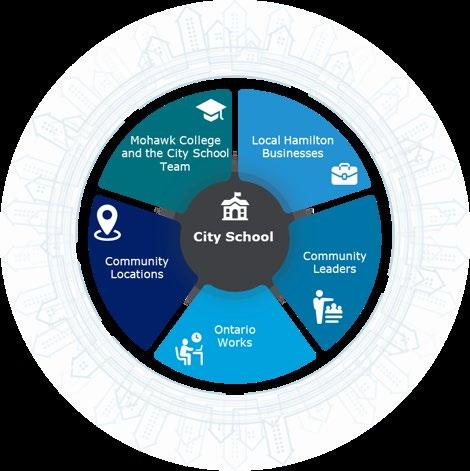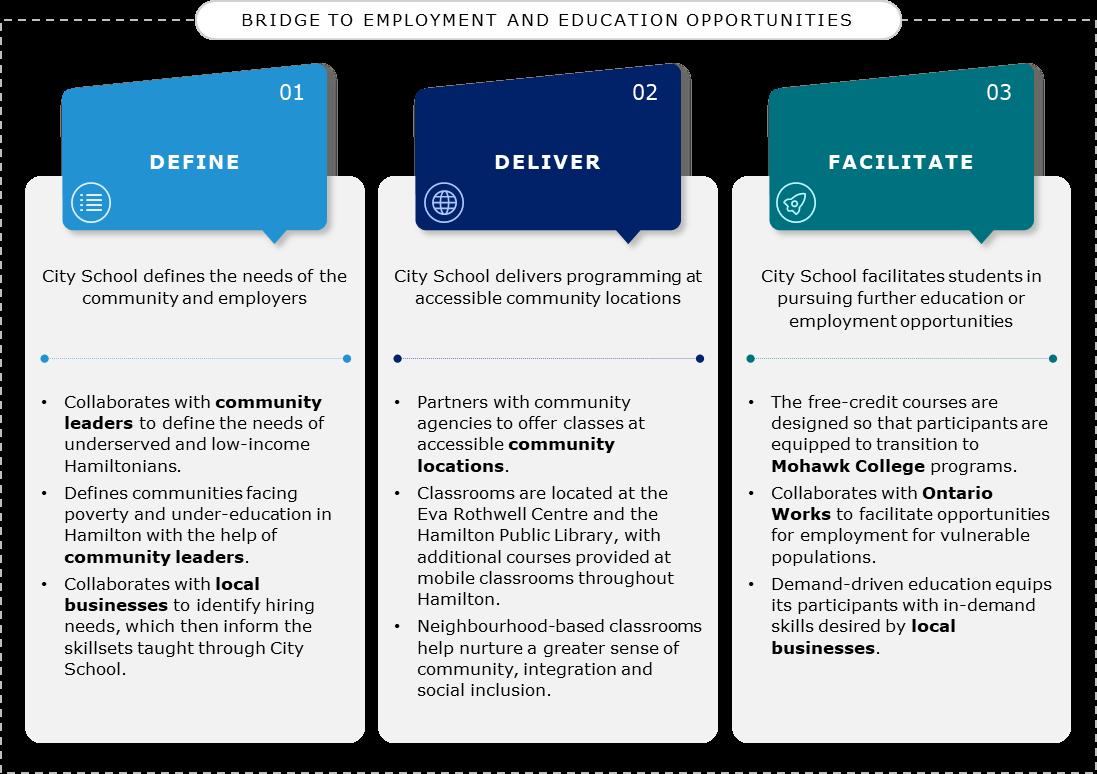
11 minute read
Setting the scene: The macroeconomic context of City School
City School does not generate impact in a vacuum. The program creates a contribution by fostering positive economic outcomes or arresting negative economic developments.
Within this context, the following chapter provides an overview of the key macro forces that are relevant to City School and its economic contribution. This background information sets the backdrop and will act as an important reference point for this report.
Amidst an economic transition period, Canada faces a skills mismatch challenge
Canada’s economy has transformed in recent decades, due to the tectonic forces of globalization and technical change. Low labour costs in global markets (e.g., Asia) and the advent of improved machinery and equipment have replaced the activities of many low and middle skilled workers. This shift impacted Canada’s traditional manufacturing sector, which has fallen as a share of economic output. It also provided tailwind to a broader economic transition, in which Canada’s economy has become more oriented towards advanced manufacturing and high-value-added services. Amidst this transition period, Canada is experiencing historically low unemployment rates. Still, many workers across the country are finding it challenging to find opportunities. Canada is experiencing rising income inequality. Non-traditional employment (e.g., contract, part time, etc.) is rising as a share of employment. Wage growth has been modest, particularly for middle skilled workers.
Figure 2: Unemployment rate in Canada, 1993 to 2019
12.0%
Figure 1: Employment in Canada’s goods producing sectors and services producing sectors, indexed 2001 = 100

50 2001 2003 2005 2007 2009
Goods-producing sector 2011 2013 2015 2017 2019
Services-producing sector
Source: Statistics Canada; Deloitte Analysis 8.0%
4.0%
0.0% 1993 1995 1997 1999 2001 2003 2005 2007 2009 2011 2013 2015 2017
Source: Statistics Canada; Deloitte Analysis
Additionally, while there are many underutilized workers, firms complain about difficultly finding employees with the skills they need. The implication is that there is a skills mismatch - workers without jobs and jobs without workers. To achieve better employment opportunities, many Canadians need skills that are in demand by employers.
Hamilton embodies broader Canadian trends
Similar to Canada as a whole, Hamilton is experiencing an economic transformation. The city is home to a prominent steel production sector. Yet, the data illustrates that the local economy has become less reliant on traditional manufacturing and more diversified. Once defined as a “steel town”, the city has developed an array of advanced manufacturing and services industries, from food production to health care, professional services, and educational services. It has also become increasingly integrated in the ‘Golden Horseshoe’, with many residents travelling to high-value-add occupations in nearby urban areas, such as Toronto, but retaining their incomes within the local Hamilton economy.
50 75 100 125 150 175 2001 2003 2005 2007 2009 2011 2013 2015 2017 2019
Figure 3: Employment in Canada’s goods producing sectors and services producing sectors, indexed 2001 = 100

Health Care and Social Assistance Goods Producing Sectors Services Producing Sectors Manufacturing
Source: Statistics Canada; Deloitte Analysis
Hamilton’s transformation has supported solid economic conditions. In recent years GDP growth has been strong, with an average of 3.0% growth from 2016 to 2018, which is well above the national and the Ontario average, while the regional unemployment rate has been low. However, these favourable headline statistics mask unfortunate underlying trends. While the city’s economy is on a positive trajectory overall, certain segments of the population are being left behind.
Figure 4: Employment in Canada’s goods producing sectors and services producing sectors, indexed 2001 = 100
0.0% 2012 2013 2014 2015 2016
Source: Statistics Canada; Deloitte Analysis
2017 2018 2019
Lower City neighbourhoods are struggling to keep up with Hamilton’s economic transformation
Within Hamilton, there are groups that do not experience an equal share of the city’s growth. Consistent with broader Canadian issues, women, visible minorities, disabled workers, youths, immigrants, and Indigenous People tend to have less opportunities and lower incomes. Additionally, a portion of the workforce that historically worked within the traditional manufacturing sector is struggling to find employment in the city’s emerging sectors.

Figure 5: Median income of women, Indigenous Peoples, Immigrants, and Visible Minorities compared to the Median Income of Hamilton ($35,319). Note, data represents the year 2016 (most recent available) and all $ values are presented in CAD.
Women -$5,447
Indigenous Peoples -$5,551
Immigrants -$9,793
Visible Minority -$10,903
-$12,000 -$6,000
Source: Statistics Canada; Deloitte Analysis
Overlaying these trends, residents of the Lower City neighbourhoods are struggling. They tend to be less educated, less employed, and more impoverished, especially relative to those in Ancaster, Dundas, and Flamborough.
Figure 6: Median income levels in select Hamilton neighbourhoods. Note, data represents the year 2016 (most recent available) and all $ values are presented in CAD.

$27,674 $32,859 $38,583 $44,246
Hamilton Lower City Hamilton Mountain Stoney Creek
Source: Statistics Canada; Deloitte Analysis
Ancaster, Dundas, Flamborough
The challenges experienced within Lower City areas are well documented. As a notable example, the Hamilton Spectator’s “Code Red” (2010) explored discrepancies in health, social, and economic metrics across the city’s
neighbourhoods. The analysis revealed several troubling findings, such as:
The gap in lifespan between the highest and lowest Hamilton neighbourhoods was a shocking 21 years. 2
A Hamilton neighbourhood in Lower Hamilton experienced 1,291 emergency room visits per 1,000 people. Meanwhile, a Hamilton neighbourhood in Flamborough experienced 97 emergency room visits per 1,000 people.
Nearly 70% of children lived below the poverty line in the neighbourhood defined by James Street North, Cannon Street East, Wellington Avenue North, and King Street East. In contrast, there were seven neighbourhoods in Hamilton where no of children lived below the poverty line. 3
In a recent update of the analysis (February 2019), the Spectator found that “in most cases, the situation has worsened.” Indeed, the gap in lifespan between the highest and lower Hamilton neighbourhoods grew to 23 years. 4
A broader labour force will lift up communities and enhance Hamilton businesses
Through its “Economic Development Action Plan - 2016- 2025”, the City of Hamilton declared an ambition to “be the best place to raise a child and age successfully.” 5 To ensure this goal is actualized across the whole city, populations that face economic challenges will need better outcomes in education, skills development, labour force participation, and employment. These objectives would help to catalyze positive health and social outcomes, reverse the trends identified in “Code Red”, and ultimately support the City of Hamilton’s goal.
Additionally, the overall economy would benefit from a larger labour force and more-skilled workers. While Hamilton is performing well, it has not reached its full potential. Consistent with national trends, a common complaint among the city’s businesses is that they have difficultly accessing qualified workers - a challenge which relates to the skills mismatch challenge experienced across Canada. Broadening opportunities to education, skills development, and employment will not only serve populations that have been left behind. It will also enhance the ability of local businesses to find and retain talent as well as create economic growth.

City School as a bridge to opportunity

To generate better outcomes in education and employment, the skills that are in demand should be identified, the population segments that are most in need should be engaged, and a platform for accessible educational opportunities should be provided. Within this context, City School represents a conduit that coordinates various local organizations to meet these requirements. Through leading these stakeholders, City School makes it possible for students to progress to further education and employment. Accordingly, the program can be understood as a bridge to opportunity.
City School delivers tuition-free educational programming
City School is an initiative created out of Mohawk College’s belief in expanding access to postsecondary education. First launched in fall semester of 2015, with for-credit courses first offered in the winter semester of 2016, the program delivers tuition-free courses and workshops to residents in Hamilton. The parameters for admission to City School are broad. Anyone 19 years or older and not enrolled in a postsecondary program is permitted entry. This said, priority is provided to individuals with little or nopostsecondary experience. Once enrolled in City School, participants can earn up to two college credits, which can then apply to college programs at Mohawk. Each semester offers an array of subjects, from Horticulture and Landscaping to Child Development and Behavior. There are also broad, entrylevel ‘College 101’ courses, designed to help participants develop core skills that are required in college.
For many participants, City School is first-time experience with college
Between winter semester 2016 and spring semester 2020, City School has enrolled 680 unique students, 496 of whom completed their course (73%). The program has grown each year in operation, with 233 unique completions taking place in the 2018/2019 academic year. Many City School participants did not have prior experience with college before entering in the program. Of the students that enrolled, 51% have a high school diploma or less education. For these students, City School is a first-time experience pursuing higher education and skills training (outside of a formal workplace). Overlaying this trend, 68% of City School students are residents of Hamilton’s Lower City Neighbourhood.

Figure 7: Breakdown of City School participants, by Hamilton CMA neighbourhood
68%
1%
Stoney Creek 1%
Ancaster,
Dundas, Flamborough 14%
Hamilton Mountain 15%
Other
Source: Statistics Canada; Deloitte Analysis
Hamilton Lower City
Mohawk College’s CCPEL leads multiple local stakeholders in delivering City School
The delivery of City School is led by Mohawk College’s Centre for Community Partnerships and Experiential Learning (CCPEL), which dedicates investment, people, and time to run the program. To host courses for the 2019/2020 semesters, this included expenditures of approximately $1,200,000 dollars, with 51% of costs covered via transfers from Mohawk College and the remaining 49% covered via grants. The College’s CCPEL staff conduct background research, engage in fundraising, and, importantly, coordinate with various local stakeholders, who also help to deliver the program. Indeed, City School is delivered as a partnership that spans several key stakeholders.

Figure 8: Mohawk College’s City School is delivered through the collaboration of various local stakeholders.
City School receives significant funding by Mohawk College, and Mohawk College’s CCPEL lead the operations and delivery of City School courses.
Hamilton Community Leaders
Hamilton Community leaders include senior leadership teams from various local education institutions, executive directors from non-profit organizations, and senior members of publications, among others. The City School team engages local community leaders, especially those working in Lower City Hamilton, to identify the needs of potential City School students and expand opportunities to participate.
Ontario Works
Ontario Works delivers temporary financial assistance for basic needs and shelter, and the provision of mandatory and discretionary benefits, employment related benefits and emergency assistance to eligible individuals and households in Hamilton. The City School team partners with Ontario Works to support individuals on social assistance programming to receive training and workplace experience.
Source: Deloitte Analysis
Mohawk College and the City School Team
Mohawk College is fully accredited and funded by the Ontario Ministry of Colleges and Universities and is a member of Colleges and Institutes Canada (CICan). Mohawk College offers over 160 programs and serves over 30,000 students annually. Under Mohawk College, the City School team works with donors, and the college’s students, faculty and staff to create a growing range of scholarships and bursaries. The City School team also supports the college’s critical partnerships and capital campaigns.

Community Locations
In the context of City School, community locations includes the Eva Rothwell Centre, a community centre located in Lower City Hamilton that partners with families living in poverty and strives to empower them to become self-sufficient, and the Hamilton Public Library, which aims to provide the communities it serves with “freedom to discover.” 6 The City School team partners with community locations so that City School programming can be delivered in locations that suit its students and, therefore, encourage participation.
Local Hamilton Businesses
In the context of City School, local Hamilton businesses broadly refer to small, medium, and large firms that operate in various sectors across the city. The City School team engages these businesses to determine employer needs and, thereafter, design courses that teach employable skills. Additionally, local Hamilton businesses participate in providing students with informational sessions on careers within their respective industries.
City School is a demand-led education initiative
By virtue of the Mohawk College’s engagement with local Hamilton businesses, City School can be understood as a demand-led education initiative. This approach centers on (i) identifying employer needs and (ii) designing educational programming that align to employer needs. Through teaching skills that are in demand, these initiatives aim to ensure that graduates achieve good employment opportunities after completing their course. In principle, demand-led education is a model that serves the mitigate Canada’s skills gap challenge. It explicitly addresses the complaints among businesses that they cannot find employees by teaching potential workers –whom may not be able to find jobs –with the skills that are in-demand.
Pillars of City’s School’s bridge to education and employment opportunities
The Mohawk College and its partners approach to deliver demand-led education can be broken down into three key pillars. Through these pillars, City School creates a bridge to education and employment opportunities and generates a meaningful array of economic and social impacts.
Figure 9: City School as a bridge to opportunity

Source: Deloitte Analysis




